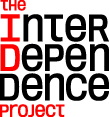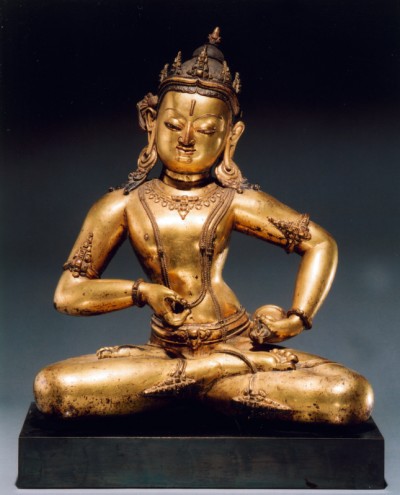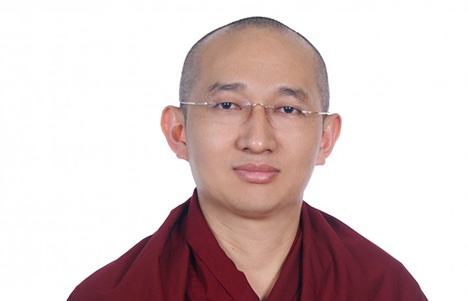
Theme: Stress Management
Vajrasattva is viewed as the Primordial Teacher (Adi-Guru). In tantric practice, one’s teacher is the Buddha, and through identification with the teacher, the practitioner attains Buddhahood. Vajrasattva appears not as a humble monk, as did Shakyamuni Buddha in his time on earth, but in a heavenly form. His perfect, supple body sways gracefully at the waist; his round arms are held dancelike; his jewels and sacred threads denote inner and outer purity; and a crown signifies his achievement.The identifying tools, or attributes, of Vajrasattva are a vajra scepter and a bell. In this image, the bell is stilled against his hip, signifying spaciousness and clarity of mind, without attachment to thoughts. This wisdom principle is identified as female.Image credit: Flying Naga, Nepal or Tibet; 14th century, Gilt copper alloy; repouse, Rubin Museum of Art,C2005.16.18 (HAR 65441)
About the Mindfulness Meditation Podcast
The Rubin Museum of Art presents a weekly meditation session led by a prominent meditation teacher from the New York area, with each session focusing on a specific work of art. This podcast is recorded in front of a live audience, and includes an opening talk, a 20-minute sitting session, and a closing discussion. The guided meditation begins at 10:32.
If you would like to attend Mindfulness Meditation sessions in person or learn more, please visit our website at RubinMuseum.org/meditation.
Presented in partnership with Sharon Salzberg and the Interdependence Project.


Related Artwork

Vajrasattva is viewed as the Primordial Teacher (Adi-Guru). In tantric practice, one’s teacher is the Buddha, and through identification with the teacher, the practitioner attains Buddhahood. Vajrasattva appears not as a humble monk, as did Shakyamuni Buddha in his time on earth, but in a heavenly form. His perfect, supple body sways gracefully at the waist; his round arms are held dancelike; his jewels and sacred threads denote inner and outer purity; and a crown signifies his achievement.The identifying tools, or attributes, of Vajrasattva are a vajra scepter and a bell. In this image, the bell is stilled against his hip, signifying spaciousness and clarity of mind, without attachment to thoughts. This wisdom principle is identified as female.
About the Teacher

The highly venerated Eighth Khangser Rinpoche, Tenzin Tsultrim Palden, was born in Kathmandu, Nepal in May 1975. At the age of 5, he was recognized as the reincarnation of the Seventh Khangser Rinpoche, who was one of the three high lamas responsible for searching for the fourteenth reincarnation of His Holiness the Dalai Lama. Khangser Rinpoche started basic study of Buddhist philosophy in the Institute of Buddhist Dialectics, Dharamsala. Thereafter, he completed advanced Buddhist studies on sutra and tantra in Sera Jey Monastery, Karnataka, and Gyuto Tantric Monastic University in India, where he obtained Geshe Lharampa and a Doctorate Degree in tantra both with highest honors among the top division. He has directly received a wealth of teachings on both Tantra and Sutra from many great Tibetan yogis and from spiritual teachers from the four major Tibetan Buddhist sects. Some of his teachers include His Holiness the Fourteenth Dalai Lama, Kyabje Dilgo Kysentse Rinpoche, Lati Rinpoche, Khensur Lobsang Tsering, Khe Tsun Sangpo Rinpoche, and Choegye Trichen Rinpoche. Khangser Rinpoche presently serves as a professor teaching buddhist philosophy at Sera Jey Monastic University, one of the three great Gelugpa Monastic Universities. In 2012 he established the Dipankara Buddhist Organization to to convey the practice of mind training all over the world. In addition he delivers public teachings on Tibetan Buddhism to diverse audiences from India, Nepal, Vietnam, China, Korea, Tibet, and the West.
